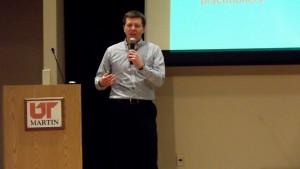The second speaker for the 2013-2014 Academic Speaker Program, Dr. John W. Schmidt from the U.S. Meat Animal Research Center, spoke in Watkins Auditorium on November 19 about bacterial antibiotic resistance in animal agriculture and human health.

Schmidt proposed there is no simple answer at the interface of these three very complex systems. He brought up the threat of infectious disease, which is currently the second leading cause of death in the world and third leading cause in the U.S.
Schmidt presented bacteria that showed antibiotic resistance and went on to elaborate on ones that have some specific link to antibiotic use in agriculture. He also illustrated several resistant mechanisms of bacteria and how resistance is conferred. For example, he discussed about selecting for resistance by using antibiotics to kill bacteria that are not resistant. This leaves the resistant bacteria to divide which ends up making a stronger bacterial strain that the antibiotic cannot kill.
After a brief history of antibiotic use in animals and explaining how any antibiotic use can lead to resistance, he went on to show how we test meat for these antibiotic resistant bacteria.
Schmidt showed how at one time we had inadequate testing for these bacteria because the samples were taken at slaughter, which doesn’t reflect the microbial populations in their production environment.
He then explained his own experiments with cows. He took a sample of cattle and used specific agriculture antibiotics to test if sustained use would lead to more antibiotic resistance. He then took fecal and hide samples from this sample of cattle every month for six months. These samples were then studied and tested for antibiotic resistant E. Coli. The results fluctuated over time with the cows using the antibiotics sometimes having lower populations of the antibiotic resistant E. Coli.
He also discussed the problems of the experiment which were related to how they used an onsite feedlot, which is different from the typical commercial feedlot. One of the major differences arises from the fact that commercial feedlots are buying and selling cattle throughout the year, while the feedlot Schmidt used had no cattle coming in from offsite.
Schmidt has a new study starting in 2014-2015 which the goal is to track resistance of bacteria by concentration residues and to try to see how the concentrations go up and down over time.


